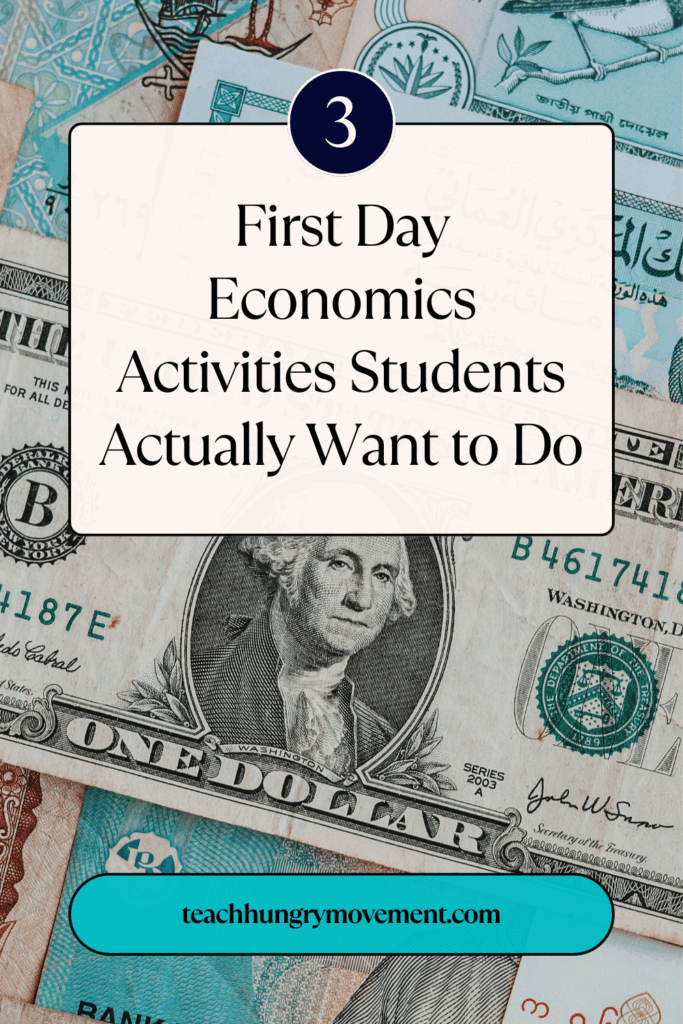The first day of Economics class can feel like a gamble.
Some students signed up because they’re curious about the economy.
Others heard it was “an easy senior elective.”
A few are there by accident, mistaking it for Accounting or Personal Finance
The best way to kick off an on-level or AP Economics course?
Not with a lecture.
Not with a syllabus read-aloud.
And definitely not with an exhaustive overview of “opportunity cost” on slide 12 of a 30-slide PowerPoint.
Start with an activity.

Something that gets kids to do economics—before they even realize it.
Here are three first-day activities that do that.
Related: Ultimate Social Studies Bundle – FREE
1. Let’s Build a Zoo!
What it teaches: Scarcity, opportunity cost, trade-offs, decision-making
Time: 45–60 minutes
Best for: Any high school Economics class (on-level or AP Micro)
If you want students to feel scarcity and make real economic decisions right away, this is the one.
Here’s how it works: Students work in small groups to design their own zoo—with one major constraint: space. They have 25 acres and a menu of animals, each of which requires a different amount of land.
But animals don’t like being alone, so they’ll need more than one of most animals. A lion takes 2 acres. An African elephant takes 15. Monkeys only need ½ acre, but how many monkeys is too many?
When they’re done, students complete a guided reflection sheet that asks questions like:
- Why didn’t you include every animal?
- What was the last animal to make the cut?
- Did everyone in your group agree on the final design?
- What kind of elephant did you choose. Why?
You connect their decisions to key economic concepts. Think scarcity, trade-offs, and opportunity cost.
Why it works:
- It feels like a game, but it is economics
- It gets students to justify their decisions using reasoning they’ll rely on all year
- It’s perfect for setting up your first unit
- It lets you model how you’ll introduce and reinforce economic concepts in the course
Related: Kick Off Your Civics Class With a Bang: 3 Activities You Can’t Miss
2. “Needs vs. Wants” Real-Life Brainstorm
What it teaches: Scarcity, limited resources, basic economic problem
Time: 20–30 minutes
Best for: On-level Economics or intro day in AP Micro
Start with a real-world curveball:
“You’ve been dropped in a brand-new country. You have no money, no connections, and only what’s in your backpack. What do you do first?”
Have students make two lists:
- Needs (essentials for survival)
- Wants (things they want, but could live without)
Then debrief:
- What was on everyone’s “needs” list?
- Did anyone disagree about whether something was a need or a want?
- What happens when there aren’t enough resources to meet even the basic needs?
Why it works:
- It grounds economic concepts in human experience
- It sets the stage for understanding scarcity, choices, and priorities
- It helps you introduce the economic problem and essential questions for the course
Want to level it up for AP? End with a short reading or mini-lecture on the “Economic Problem” and the role of incentives in decision-making.
Related: Make Day One U.S. History The Best Class They Walk Into
3. “$100 Dilemma” Budget Simulation
What it teaches: Opportunity cost, marginal benefit vs. marginal cost, utility
Time: 20–40 minutes
Best for: AP Microeconomics or any class focused on decision-making early on
Pose the challenge:
“You have $100. You can spend it any way you want—but once it’s gone, it’s gone.”
Give students a list of 20+ items with prices (or let them brainstorm their own). Some essentials, some splurges.
- $35 concert ticket
- $10 for lunch out
- $25 toward savings
- $15 for new shoes
- $5 coffee run
- $20 for a gift for a friend
Then ask them to:
- Rank their purchases
- Calculate what they gave up when they chose one item over another
- Reflect on what they valued most
Follow up with a quick discussion:
- What was your biggest “opportunity cost”?
- What did you almost buy but didn’t? Why?
- Would you make the same choices tomorrow?
Why it works:
- Students practice marginal thinking right away
- It’s a personal activity that helps them see economics in everyday life
- It’s adaptable into a full lesson or quick icebreaker
Related: 3 Engaging Ways to Powerfully Launch Your World History Class
Final Thought:
The first day of Economics class doesn’t have to be a lecture.
And it definitely doesn’t have to feel like a list of definitions.
Start with activities that let students do economics.
You’ll hook them early, build buy-in, and set the tone for a course that’s relevant, rigorous, and actually fun.
Whether you’re teaching AP or on-level, these activities do more than capture students’ attention. They show them that economics is everywhere, and it starts with the choices they make every day.
Don’t forget! Ultimate Social Studies Bundle – FREE
+ show Comments
- Hide Comments
add a comment